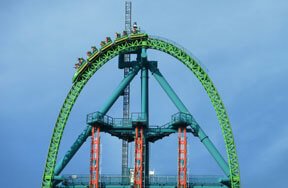Famous Greenerlanders
Knud Rasmussen: One of the most famous arctic explorers. He studied the land and ice, the weather, wildlife and people. Almost everything we know about the Far North can be read in books written by him.
Oavigarssuag: His name means 'Big Eider Duck.' This duck was an important guide for Knud on a three-year trip across Canada to Alaska. For his work the Danish Government gave him metals in Copenhagen and he also went to Washington D.C. and met President Coolidge.
Robert Peary: This explorer is credited with being the first to reach the North Pole in 1909. Although Robert might be the most famous for doing his explorations, Knud provided more information about the arctic.
Brief History
Greenland's history reads something like this: Nothing much happened, still nothing happened. A couple of guys arrived but left right away. Nothing else happened for hundreds of years. Another guy (with red hair) arrived, stayed for a bit and then left. A few more centuries past and nothing happened. Greenland had no bloody wars, throne stealing or stories of betrayal because of the small population in a big area and just trying to survive in the harsh conditions took up too much time.
Not much is known about the beginning. A few tribes died out but no one knows why. In the 10th century the Thule (pronounced too-lee) arrived and introduced kayaks and dogsleds. The Vikings arrived not that long after and Erik the Red called the island Greenland thinking the colorful name would attract more people to the island.
Norway officially took over Greenland in the 13th century but later lost it to Denmark, which claimed the island in the 17th century. When World War II broke out the US took over custody of Greenland. In '79 Greenland voted for home rule and six years later the island broke away from Europe.
Local critters
Seals: About two million seals live in Greenland waters.
Musk Oxen: These shaggy beasts look like a cross between a buffalo and a yak. On their head they have a horn that grows outward into two slightly curved sharp points. The outside layer of hair (they have two layers) can grow as long as 16 inches (1.3 feet) and hangs low enough to cover their short, stocky legs.
Reindeer: Maybe this is where Santa keeps his herd when he's not using them? Reindeer live all over Greenland in the areas that aren't covered in ice.
Polar Bears: They mostly live in the north and east but they also drift on field ice to the south, sipping Coca-Cola.
Cool Things to See and Do
Mush: Dogsleds can be found in Sisimiut, Northwest Coast and along all of the East Coast. As tourist, the riding is better in March and April. Tours can last from a few hours to several weeks.
Fjord!: Every March the capital city, Nuuk, has an international snow-sculpture festival. At the same time Uummannaq fjord hosts an off the wall event - The World Ice Golf Championships. Instead of hearing 'Fore!' you'll hear 'Fjord!'
Largest Ice Cube: If you want to see one of the largest ice cubes check out Sermeq Kujalliq. The face of the glacier is 5kms (3 meters) wide and who knows how many meters thick. It's the world's biggest glacier outside Antarctica. The only way to reach the glacier is by helicopter.
Fun facts
Greenland isn't actually green. Over eighty percent of the island (1.8 million square kilometers or 1.1 square miles) is covered with ice. Only Antarctica has more ice.
Greenland is the largest island in the world. It is three times the size of Texas.
If you can only stay out 'til it's dark head to Greenland. During the Arctic summer the sun never sets. In Ilulissat the sun never sets from May 25th to July 25th.
On a clear night in the autumn you can see the winter and spring northern lights sweep across the dark sky.
July is the only month that Greenland's temperature averages above freezing.
About 10,000 to 15,000 icebergs are calved by Greenland's glaciers each year. Calved is when ice breaks off or away from a glacier. When the ice calves off the glaciers there is a huge explosion that sounds like a bomb.
Related Stories:































